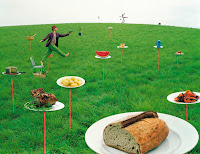Tequila~Key Lime Tarts with Tequila Caviar
 This recipe is for the more advanced chef and combines two of my favorite things; Tequila as an ingredient and a bit of Molecular Gastronomy as a method that you can do at home. You can simply make the Tarts and leave it at that, but for you more adventurous chefs, I've included the recipe for the Tequila Caviar as well. Good Luck!
This recipe is for the more advanced chef and combines two of my favorite things; Tequila as an ingredient and a bit of Molecular Gastronomy as a method that you can do at home. You can simply make the Tarts and leave it at that, but for you more adventurous chefs, I've included the recipe for the Tequila Caviar as well. Good Luck!Ingredients
Graham Crust
1 lb. graham cracker crumbs
8 oz sugar
4 oz pastry flour
8 oz melted butter
Sugar dough
2 lb butter
12 oz sugar
1/4 oz salt
9 oz eggs
3 lb pastry flour
Method
Graham crust: Mix well and set aside.
Sugar dough: Mix the butter, sugar and salt at low speed, add eggs, flour and mix just until evenly blended. Chill for a few hours before using.
Filling
Ingredients
14 oz sweetened condensed milk
3 egg yolks
3 oz key lime juice
1 oz tequila
Mix well and refrigerate
To Assemble
First, decide if you are going to use a sugar dough base or a graham base. If you choose sugar dough you will need to roll out the dough after it has chilled and form it in to your tart pan or pie pan. If you opt for graham, form the graham into the mold by simply pressing it in. Both shells need to be par baked for 12-15 minutes. While the tarts are baking prepare the filling. Fill the molds with key lime filling and bake for about 15 minutes or until filling is set. Let cool and remove from pan. Decorate and serve.
For you adventurous chefs, here is how to make the Tequila Caviar.
 Tequila Caviar
Tequila CaviarIngredients
3 oz simple syrup
3 oz key lime juice
3 oz tequila
.8% agar agar
.2 % locust bean gum
Frozen vegetable oil
Method
One day prior to assembly put oil in the freezer. The day you are making the caviar, remove the oil from freezer 1 hour before using. Allow the oil to defrost, but keep it cold. Mix juice, tequila, agar agar and locust bean gum using a hand held mixer for about 1 minute. Let mix sit for a few hours to allow some of the bubbles to disappear. Bring caviar mix to a boil and strain.
 When the caviar mix is ready, it needs to be warm and the oil needs to be cold. Pour the hot mix into a piping bag. Cut a very tiny hole in the bag, so small that you have to squeeze a bit to get the drips out. Above the oil, start squeezing out the mix in small drops using a circular motion. You can adjust the size of the caviar by adjusting your height above the oil. Further away makes smaller balls, closer makes larger balls. The caviar will sink to the bottom of the bowl as the mix gets warmer. Once the mix is done, strain the oil and the caviar will remain in the sieve. Delicately rinse the caviar in cold water and use as decoration.
When the caviar mix is ready, it needs to be warm and the oil needs to be cold. Pour the hot mix into a piping bag. Cut a very tiny hole in the bag, so small that you have to squeeze a bit to get the drips out. Above the oil, start squeezing out the mix in small drops using a circular motion. You can adjust the size of the caviar by adjusting your height above the oil. Further away makes smaller balls, closer makes larger balls. The caviar will sink to the bottom of the bowl as the mix gets warmer. Once the mix is done, strain the oil and the caviar will remain in the sieve. Delicately rinse the caviar in cold water and use as decoration.I hope you try the recipe for the Caviar for yourselves and don't worry if your first attempt doesn't come out quite right. It took me three tries to get the Caviar method down, so don't be discouraged. As with everything, practice make perfect and remember; the plating here was done specifically for presentation and publishing purposes. Just get creative with your plating and enjoy the wonderful flavors that will wow your friends and family.
Bon Appetit










